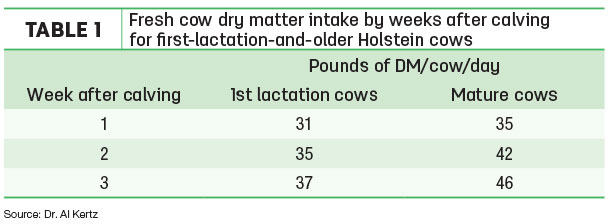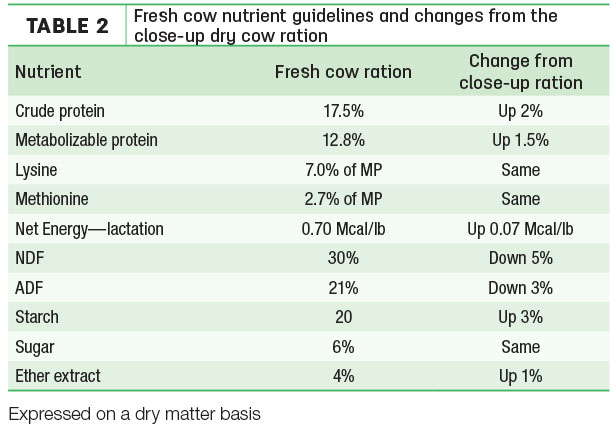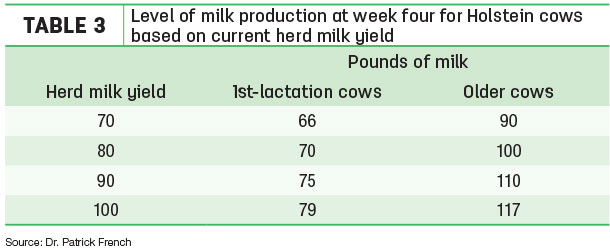Your fresh cow program can make or break the economic success and health of each cow’s lactation. It is important to get these transitioning cows off to a solid start.
Three fresh cow pillars that can ensure a successful transit are outlined below.
Pillar 1 – Fresh cow rations
Developing a fresh cow feeding program bridges the transition from the close-up or dry cow ration to the high-group ration. One guideline is: The nutrient change should not increase or decrease by more than 10 percent of the level of the nutrient.
For example, if starch content in the close-up ration is 18 percent, shifting the fresh cow group to 20 to 21 percent starch allows the rumen microbes and environment to adjust to a higher-starch diet before being placed in the high-group ration containing 24 to 28 percent starch.
The level of dry matter intake listed in Table 1 by week after calving can serve as a guideline for your fresh cow group.

The rate of dry matter increase after calving is faster for older cows compared to first-lactation cows (heifers), and first-lactation cows are lower. Compare these values to your fresh cow group ration.
If your dry matter intake lags, review the close-up cow and heifer program, transition diets and social competition. Nutrient guidelines for the fresh ration are listed in Table 2 with the change of each nutrient from the close-up dry cow ration.

Evaluate effective neutral detergent fiber levels using the Penn State Particle Box in the fresh cow ration. Add in 1 or 1.5 pounds of straw or 3 to 5 pounds of long hay. (Forages should be processed prior to mixing to avoid sorting and maintain a uniform mix.) If cows are locked up daily for 30 to 45 minutes for health checks or housed in tiestalls, the added high-quality hay could be top-dressed and monitored as an index of appetite.
Pillar 2 – Graduation day
When should fresh cows move to the next production group? This decision should not be made on a cow’s days in milk or new fresh cows entering the pen, but based on trends and changes in each individual cow.
By developing a unique scoring system tailored specifically to your farm, fresh cows should “graduate” from the fresh cow pens based on this criteria list and what fits your management protocol, labor availability and facilities:
-
Uterine discharge. Evaluating the discharge from the uterus can reflect if an infection or part of the placenta remains. Recording scores: Score 1 – no or clear thick discharge, Score 2 – has thick discharge with minimal odor or Score 3 – fluid has foul-smelling odor with abnormal color (brown to red).
-
Body temperature. This protocol can be difficult to track, as you may need to take manual temperatures unless the cow has a temperature-recording device. An increase in temperature can reflect whether the cow has an infection and may require veterinarian attention and intervention.
Be sure to adjust for environmental temperature. When heat stress occurs, body temperatures can be 1 or more degrees higher than normal. Recording scores: Score 1 – normal temperature, Score 2 – an elevated temperature or Score 3 – if the temperature is 2 degrees above normal.
-
Fecal score. Record manure behind locked-up fresh cows. Recording scores: Score 1 – manure stacks up and forms a concentric circle, Score 2 – manure is loose and runny with undigested feed particles or Score 3 – manure is fluid and watery (diarrhea). Score 1 or 2 are acceptable; Score 3 is a concern.
-
Appetite. This measure is difficult, as individual feed intake cannot be measured on most farms. One approach to consider is: After cows are locked up in the headlocks or tiestalls, observe the feed presented after 15 minutes. Another approach is to top-dress 2 or 3 pounds or a flake of high-quality hay and evaluate the cow’s consumption of the palatable forage.
Recording scores: Score 1 – feed is partially consumed, Score 2 – little feed is consumed or Score 3 – no feed is consumed.
-
Physical appearance. This tool requires a trained person to observe if cows “look” abnormal. Recording scores: Score 1 – cow is alert, bright, willing to walk aggressively and healthy; Score 2 – cow does not look “right” or Score 3 – cow has droopy ears, sunken eyes and is slow to move.
-
Milk yield change. This can be monitored on farms with recorded milk weights. Fresh cows should increase in milk production by 0.5 to 1 pound per day after calving. Recording scores: Score 1 – cow fits the normal increase (Table 3), Score 2 – cow is not responding in milk yield.

-
Rumination level. This can be evaluated on farms using rumination collars or tags. Fresh cows should reach greater than 450 rumination minutes per day at five to seven days after calving. Recording scores: Score 1 – cow is normal at greater than 450 minutes, Score 2 – cows are increasing slowly or Score 3 – cows are declining in rumination minutes.
-
Blood or milk ketone test. Some dairy managers conduct an analysis on-farm using a blood test strip or milk ketone test. Dairy Herd Improvement can also measure milk ketone levels by testing all fresh cow milk once a week and sending the tests to a lab to measure results. Recording scores: Score 1 – the cow is normal, Score 2 – a slightly elevated ketone level (modest level increase) or Score 3 – a high ketone level.
- CMT paddle test. Conducting a California Mastitis Test (CMT) can reflect if the cow has an elevated somatic cell count. Continue to monitor to determine whether the somatic cell count level comes down or reaches a target level. Recording scores: Score 1 – normal somatic cell count or a CMT 1, Score 2 – CMT 2 or Score 3 – CMT 3.
Pillar 3 – Cow comfort
Fresh cows are under a lot of stress at calving with hormonal changes, strain of delivering a calf, starting their milking routine, entering a new group of cows and environment changes. The following areas merit consideration based on your facilities and labor situation:
- Creating a fresh heifer group (first-lactation cows) if possible: This allows for less competitive interactions with older and larger cows and a ration based on the reduced dry matter intake.
- Increasing feedbunk space during the transition period to increase feed intake and milk production
- Allowing adequate stall space and stocking density: Less than 0.9 animal per available stall should be the goal in the fresh cow group.
- Providing deep sand bedding or other bedding material to increase cow lying time and comfort: A bedded pack or compost barn system can also be successful to optimize fresh cow comfort.
- Allowing springing heifers to walk through the milking parlor can get heifers accustomed to the sounds and activity in the parlor before attaching a milking machine.
- Creating a springing heifer group if possible: Nutrients can be fed to improve heifer health, especially trace mineral, vitamins and needed additives.


-
Michael Hutjens
- Professor of Animal Sciences Emeritus
- University of Illinois – Urbana
- Email Michael Hutjens






